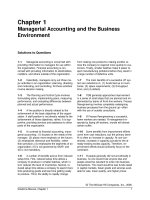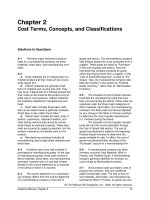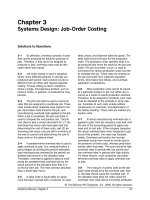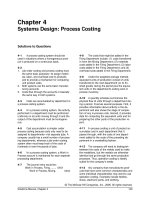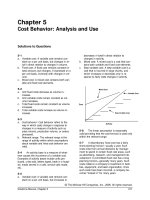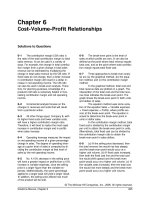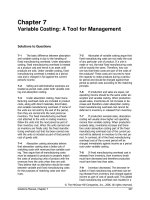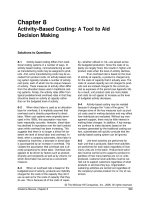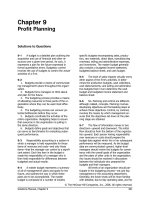Solutions to question managerial accounting ch03 sysstems design job order costing
Bạn đang xem bản rút gọn của tài liệu. Xem và tải ngay bản đầy đủ của tài liệu tại đây (172.07 KB, 75 trang )
Chapter 3
Systems Design: Job-Order Costing
Solutions to Questions
3-1
By definition, overhead consists of costs
that cannot practically be traced to products or
jobs. Therefore, if they are to be assigned to
products or jobs, overhead costs must be allocated rather than traced.
3-2
Job-order costing is used in situations
where many different products or services are
produced each period. Each product (or job) is
different from all others and requires separate
costing. Process costing is used in situations
where a single, homogeneous product, such as
cement, bricks, or gasoline, is produced for long
periods.
3-3
The job cost sheet is used to record all
costs that are assigned to a particular job. These
costs include direct materials costs traced to the
job, direct labor costs traced to the job, and
manufacturing overhead costs applied to the job.
When a job is completed, the job cost sheet is
used to compute the unit product cost. The job
cost sheet is also a control document for: (1) determining how many units have been sold and
determining the cost of these units; and (2) determining how many units are still in inventory at
the end of a period and determining the cost of
these units on the balance sheet.
3-4
A predetermined overhead rate is used to
apply overhead to jobs. It is computed before a
period begins by dividing the period’s estimated
total manufacturing overhead by the period’s estimated total amount in the allocation base.
Thereafter, overhead is applied to jobs by multiplying the predetermined overhead rate by the
actual amount of the allocation base that is incurred for each job. The most common allocation
base is direct labor-hours.
3-5
A sales order is issued after an agreement has been reached with a customer on quan-
tities, prices, and shipment dates for goods. The
sales order forms the basis for the production
order. The production order specifies what is to
be produced and forms the basis for the job cost
sheet. The job cost sheet, in turn, is used to
summarize the various production costs incurred
to complete the job. These costs are entered on
the job cost sheet from materials requisition
forms, direct labor time tickets, and overhead
application computations.
3-6
Many production costs cannot be traced
to a particular product or job, but rather are incurred as a result of overall production activities.
Therefore, to be assigned to products, such costs
must be allocated to the products in some manner. Examples of such costs include utilities,
maintenance on machines, and depreciation of
the factory building. These costs are indirect production costs.
3-7
If actual manufacturing overhead cost is
applied to jobs, then the company must wait until
the end of the accounting period to apply overhead and to cost jobs. If the company computes
the actual overhead rates more frequently to get
around this problem, the rates may fluctuate
widely. Overhead cost tends to be incurred
somewhat evenly from month to month (due to
the presence of fixed costs), whereas production
activity often fluctuates. The result would be high
overhead rates in periods with low activity and
low overhead rates in periods with high activity.
For these reasons, most companies use predetermined overhead rates to apply overhead cost
to jobs.
3-8
The measure of activity used as the allocation base should drive the overhead cost; that
is, the base should cause the overhead cost. If
the allocation base does not really cause the
overhead, then costs will be incorrectly attributed
© The McGraw-Hill Companies, Inc., 2006. All rights reserved.
Solutions Manual, Chapter 3
67
to products and jobs and their product costs will
be distorted.
3-9
Assigning overhead costs to jobs does not
ensure a profit. The units produced may not be
sold and if they are sold, they may not in fact be
sold at prices sufficient to cover all costs. It is a
myth that assigning costs to products or jobs ensures that those costs will be recovered. Costs are
recovered only by selling to customers—not by
allocating costs.
3-10 The Manufacturing Overhead account is
credited when overhead cost is applied to Work in
Process. Generally, the amount of overhead applied will not be the same as the amount of actual
cost incurred, since the predetermined overhead
rate is based on estimates.
3-11 Underapplied overhead occurs when the
actual overhead cost exceeds the amount of
overhead cost applied to Work in Process inventory during the period. Overapplied overhead occurs when the actual overhead cost is less than
the amount of overhead cost applied to Work in
Process inventory during the period. Under- or
overapplied overhead is disposed of by either
closing out the amount to Cost of Goods Sold or
allocating the amount among Cost of Goods Sold
and ending inventories in proportion to the applied overhead in each account. The adjustment
for underapplied overhead increases Cost of
Goods Sold (and inventories) whereas the adjustment for overapplied overhead decreases Cost
of Goods Sold (and inventories).
3-12 Overhead may be underapplied for several reasons. Control over overhead spending
may be poor. Or, some of the overhead may be
fixed and the actual amount of the allocation base
was less than estimated at the beginning of the
period. In this situation, the amount of overhead
applied to inventory will be less than the actual
overhead cost incurred.
3-13 Underapplied overhead implies that not
enough overhead was assigned to jobs during the
period and therefore cost of goods sold was understated. Therefore, underapplied overhead is
added to cost of goods sold. Likewise, overapplied overhead is deducted from cost of goods
sold.
3-14 Yes, overhead should be applied to properly value the Work in Process inventory at yearend. Since $6,000 of overhead was applied to Job
A on the basis of $8,000 of direct labor cost, the
company’s predetermined overhead rate must be
75% of direct labor cost. Thus, $3,000 of overhead should be applied to Job B at year-end:
$4,000 direct labor cost × 75% = $3,000 applied
overhead cost.
3-15
Direct material .................................. $10,000
Direct labor....................................... 12,000
Manufacturing overhead:
$12,000 × 125% ............................ 15,000
Total manufacturing cost.................... $37,000
Unit product cost:
$37,000 ÷ 1,000 units ....................
$37
3-16 A plantwide overhead rate is a single
overhead rate used throughout all production departments in a plant. Some companies use multiple overhead rates rather than plantwide rates to
more appropriately allocate overhead costs
among products. Multiple overhead rates should
be used, for example, in situations where one
department is machine intensive and another department is labor intensive.
3-17 When automated equipment replaces
direct labor, overhead increases and direct labor
decreases. This results in an increase in the predetermined overhead rate—particularly if it is
based on direct labor.
3-18 When the predetermined overhead rate is
based on the amount of the allocation base at
capacity and the plant is operated at less than
capacity, overhead will ordinarily be underapplied.
This occurs because actual activity is less than the
activity the predetermined overhead rate is based
on.
3-19 Critics of current practice advocate disclosing underapplied overhead on the income
statement as Cost of Unused Capacity—a period
expense. This would highlight the amount rather
than burying it in other accounts.
© The McGraw-Hill Companies, Inc., 2006. All rights reserved.
68
Managerial Accounting, 11th Edition
Exercise 3-1 (10 minutes)
a.
b.
c.
d.
e.
f.
Process costing
Job-order costing
Process costing
Process costing
Process costing
Job-order costing
g.
h.
i.
j.
k.
l.
Job-order costing
Process costing*
Job-order costing
Process costing*
Job-order costing
Job-order costing
* Some of the companies listed might use either a job-order or a process
costing system, depending on how operations are carried out. For example, a chemical manufacturer would typically operate with a process
costing system, but a job-order costing system might be used if products are manufactured in relatively small batches. The same thing might
be true of the tire manufacturing plant in item “j.”
© The McGraw-Hill Companies, Inc., 2006. All rights reserved.
Solutions Manual, Chapter 3
69
Exercise 3-2 (15 minutes)
1. These costs would have been recorded on four different documents: the
materials requisition form for Job W456, the time ticket for Jamie Unser,
the time ticket for Melissa Chan, and the job cost sheet for Job W456.
2. The costs would have been recorded as follows:
Materials requisition form:
Quantity
Blanks
Nibs
20
480
Unit Cost
$15.00
$1.25
Total Cost
$300
600
$900
Time ticket for Jamie Unser
Started
Ended
11:00 AM 2:45 PM
Time
Completed
3.75
Rate
Amount
Job Number
Rate
Amount
Job Number
$9.60
$36.00
W456
Time ticket for Melissa Chan
Started
Ended
8:15 AM 11:30 AM
Time
Completed
3.25
$12.20
$39.65
W456
Job Cost Sheet for Job W456
Direct materials ............. $900.00
Direct labor:
Jamie Unser ................
36.00
Melissa Chan...............
39.65
$975.65
© The McGraw-Hill Companies, Inc., 2006. All rights reserved.
70
Managerial Accounting, 11th Edition
Exercise 3-3 (10 minutes)
The predetermined overhead rate is computed as follows:
Estimated total manufacturing overhead ...........
÷ Estimated total direct labor hours (DLHs).......
= Predetermined overhead rate........................
$134,000
20,000 DLHs
$6.70 per DLH
© The McGraw-Hill Companies, Inc., 2006. All rights reserved.
Solutions Manual, Chapter 3
71
Exercise 3-4 (15 minutes)
a. Raw Materials .....................
Accounts Payable...........
80,000
b. Work in Process ..................
Manufacturing Overhead .....
Raw Materials................
62,000
9,000
c. Work in Process ..................
Manufacturing Overhead .....
Wages Payable ..............
101,000
11,000
d. Manufacturing Overhead .....
Various Accounts ...........
175,000
80,000
71,000
112,000
175,000
© The McGraw-Hill Companies, Inc., 2006. All rights reserved.
72
Managerial Accounting, 11th Edition
Exercise 3-5 (10 minutes)
Actual direct labor-hours ...............................
10,800
× Predetermined overhead rate.....................
$23.40
= Manufacturing overhead applied................. $252,720
© The McGraw-Hill Companies, Inc., 2006. All rights reserved.
Solutions Manual, Chapter 3
73
Exercise 3-6 (15 minutes)
1. Actual manufacturing overhead costs ...........
Manufacturing overhead cost applied:
19,400 MH × $25 per MH .........................
Overapplied overhead cost ..........................
2.
$473,000
485,000
$ 12,000
Chang Company
Schedule of Cost of Goods Manufactured
Direct materials:
Raw materials inventory, beginning ........... $ 20,000
Add purchases of raw materials ................. 400,000
Raw materials available for use ................. 420,000
Deduct raw materials inventory, ending .....
30,000
Raw materials used in production .............. 390,000
Less indirect materials ..............................
15,000 $375,000
Direct labor ................................................
60,000
Manufacturing overhead cost applied to
work in process ........................................
485,000
Total manufacturing costs............................
920,000
Add: Work in process, beginning ..................
40,000
960,000
Deduct: Work in process, ending..................
70,000
Cost of goods manufactured ........................
$890,000
© The McGraw-Hill Companies, Inc., 2006. All rights reserved.
74
Managerial Accounting, 11th Edition
Exercise 3-7 (20 minutes)
Parts 1 and 2.
Cash
(b)
(c)
(e)
(b)
(c)
(d)
94,000
132,000
143,000
(a)
(c)
(d)
Work in Process
78,000
112,000
152,000
342,000
342,000
Raw Materials
94,000
89,000
(b)
(f)
Finished Goods
342,000
342,000
342,000
(f)
(f)
(g)
Cost of Goods Sold
342,000
22,000
364,000
(a)
(f)
Manufacturing Overhead
11,000
152,000
20,000
143,000
22,000
22,000
(e)
(g)
© The McGraw-Hill Companies, Inc., 2006. All rights reserved.
Solutions Manual, Chapter 3
75
Exercise 3-8 (10 minutes)
1. Actual direct labor-hours............................
11,500
× Predetermined overhead rate .................
$18.20
= Manufacturing overhead applied ............. $209,300
Less: Manufacturing overhead incurred....... 215,000
$ (5,700)
Manufacturing overhead underapplied ........
$5,700
2. Since manufacturing overhead is underapplied, the cost of goods sold
would be increased by $5,700 and the gross margin would decrease by
$5,700.
© The McGraw-Hill Companies, Inc., 2006. All rights reserved.
76
Managerial Accounting, 11th Edition
Exercise 3-9 (15 minutes)
1. Cutting Department:
Predetermined = Estimated total manufacturing overhead cost
overhead rate
Estimated total amount of the allocation base
=
$360,000
= $7.50 per MH
48,000 MHs
Finishing Department:
Predetermined = Estimated total manufacturing overhead cost
overhead rate
Estimated total amount of the allocation base
=
$486,000
= 180% of direct
labor cost
$270,000 direct labor cost
2.
Cutting Department: 80 MHs × $7.50 per MH ......
Finishing Department: $150 × 180%...................
Total overhead cost applied ................................
Overhead Applied
$600
270
$870
3. Yes; if some jobs required a large amount of machine time and little labor cost, they would be charged substantially less overhead cost if a
plantwide rate based on direct labor cost were being used. It appears,
for example, that this would be true of Job 203 which required considerable machine time to complete, but required only a small amount of
labor cost.
© The McGraw-Hill Companies, Inc., 2006. All rights reserved.
Solutions Manual, Chapter 3
77
Exercise 3-10 (30 minutes)
1. a. Raw Materials Inventory ..........................
Accounts Payable ..................................
210,000
b. Work in Process ......................................
Manufacturing Overhead ..........................
Raw Materials Inventory ........................
178,000
12,000
c. Work in Process ......................................
Manufacturing Overhead ..........................
Salaries and Wages Payable...................
90,000
110,000
d. Manufacturing Overhead ..........................
Accumulated Depreciation .....................
40,000
e. Manufacturing Overhead ..........................
Accounts Payable ..................................
70,000
f.
210,000
190,000
200,000
40,000
70,000
Work in Process ......................................
Manufacturing Overhead .......................
30,000 MH × $8 per MH = $240,000.
240,000
g. Finished Goods........................................
Work in Process ....................................
520,000
h. Cost of Goods Sold ..................................
Finished Goods .....................................
480,000
Accounts Receivable ................................
Sales....................................................
$480,000 × 1.25 = $600,000.
600,000
240,000
520,000
480,000
600,000
© The McGraw-Hill Companies, Inc., 2006. All rights reserved.
78
Managerial Accounting, 11th Edition
Exercise 3-10 (continued)
2.
(b)
(c)
(d)
(e)
Manufacturing Overhead
12,000
240,000
(f)
110,000
40,000
70,000
8,000
(Overapplied
overhead)
Bal.
(b)
(c)
(f)
Bal.
Work in Process
42,000
520,000
178,000
90,000
240,000
30,000
(g)
© The McGraw-Hill Companies, Inc., 2006. All rights reserved.
Solutions Manual, Chapter 3
79
Exercise 3-11 (30 minutes)
1. Since $120,000 of studio overhead was applied to Work in Process on
the basis of $75,000 of direct staff costs, the apparent predetermined
overhead rate is 160%:
Studio overhead applied
$120,000
=
= 160% rate.
Direct staff costs incurred
$75,000
2. The Lexington Gardens Project is the only job remaining in Work in
Process at the end of the month; therefore, the entire $35,000 balance
in the Work in Process account at that point must apply to it. Recognizing that the predetermined overhead rate is 160% of direct staff costs,
the following computation can be made:
Total cost in the Lexington Gardens Project........
$35,000
Less: Direct staff costs.................................... $ 6,500
Studio overhead cost ($6,500 × 160%)... 10,400 16,900
Costs of subcontracted work .............................
$18,100
With this information, we can now complete the job cost sheet for the
Lexington Gardens Project:
Costs of subcontracted work ........
Direct staff costs .........................
Studio overhead..........................
Total cost to January 31 ..............
$18,100
6,500
10,400
$35,000
© The McGraw-Hill Companies, Inc., 2006. All rights reserved.
80
Managerial Accounting, 11th Edition
Exercise 3-12 (30 minutes)
Note to the instructor: This exercise is a good vehicle for introducing the
concept of predetermined overhead rates. This exercise can also be used
as a launching pad for a discussion of the appendix to the chapter.
1. Since manufacturing overhead is mostly fixed, the cost per unit increases as the level of production decreases. This apparent problem can
be “solved” using predetermined overhead rates, which should be based
on expected activity for the entire year. Many students will use units of
product in computing the predetermined overhead rate, as follows:
Predetermined = Estimated total manufacturing overhead cost
overhead rate
Estimated total amount of the allocation base
=
$960,000
= $4.80 per unit.
200,000 units
The predetermined overhead rate could also be set on the basis of either direct labor cost or direct materials cost. The computations are:
Predetermined = Estimated total manufacturing overhead cost
overhead rate
Estimated total amount of the allocation base
=
$960,000
= 300% of direct
labor cost.
$320,000 direct labor cost
Predetermined = Estimated total manufacturing overhead cost
overhead rate
Estimated total amount of the allocation base
=
$960,000
= 160% of direct
materials cost.
$600,000 direct materials cost
© The McGraw-Hill Companies, Inc., 2006. All rights reserved.
Solutions Manual, Chapter 3
81
Exercise 3-12 (continued)
2. Using a predetermined overhead rate, the unit product costs would be:
First
Quarter
Second
Third
Fourth
Direct materials .................. $240,000 $120,000 $ 60,000 $180,000
Direct labor ........................ 128,000
64,000
32,000
96,000
Manufacturing overhead:
Applied at $4.80 per unit,
300% of direct labor
cost, or 160% of direct
96,000 288,000
materials cost .................. 384,000 192,000
Total cost ........................... $752,000 $376,000 $188,000 $564,000
Number of units produced ...
80,000
40,000
20,000
60,000
Unit product cost ................
$9.40
$9.40
$9.40
$9.40
© The McGraw-Hill Companies, Inc., 2006. All rights reserved.
82
Managerial Accounting, 11th Edition
Exercise 3-13 (30 minutes)
1.
Predetermined = Estimated total manufacturing overhead cost
overhead rate
Estimated total amount of the allocation base
=
$192,000
= $2.40 per MH
80,000 MHs
2. The amount of overhead cost applied to Work in Process for the year
would be: 75,000 machine-hours × $2.40 per machine-hour =
$180,000. This amount is shown in entry (a) below:
(Maintenance)
(Indirect materials)
(Indirect labor)
(Utilities)
(Insurance)
(Depreciation)
Balance
(Direct materials)
(Direct labor)
(Overhead)
(a)
Manufacturing
Overhead
21,000
180,000
8,000
60,000
32,000
7,000
56,000
4,000
(a)
Work in Process
710,000
90,000
180,000
3. Overhead is underapplied by $4,000 for the year, as shown in the Manufacturing Overhead account above. The entry to close out this balance
to Cost of Goods Sold would be:
Cost of Goods Sold .....................................
Manufacturing Overhead........................
4,000
4,000
© The McGraw-Hill Companies, Inc., 2006. All rights reserved.
Solutions Manual, Chapter 3
83
Exercise 3-13 (continued)
4. When overhead is applied using a predetermined rate based on machine-hours, it is assumed that overhead cost is proportional to machine-hours. So when the actual machine-hours turn out to be 75,000,
the costing system assumes that the overhead will be 75,000 machinehours × $2.40 per machine-hour, or $180,000. This is a drop of $12,000
from the initial estimated manufacturing overhead cost of $192,000.
However, the actual manufacturing overhead did not drop by this much.
The actual manufacturing overhead was $184,000—a drop of $8,000
from the estimate. The manufacturing overhead did not decline by the
full $12,000 because of the existence of fixed costs and/or because
overhead spending was not under control. These issues will be covered
in more detail in later chapters.
© The McGraw-Hill Companies, Inc., 2006. All rights reserved.
84
Managerial Accounting, 11th Edition
Exercise 3-14 (15 minutes)
1. Item
Item
Item
Item
(a):
(b):
(c):
(d):
Actual manufacturing overhead costs for the year.
Overhead cost applied to work in process for the year.
Cost of goods manufactured for the year.
Cost of goods sold for the year.
2. Cost of Goods Sold.........................................
Manufacturing Overhead ...........................
70,000
70,000
3. The underapplied overhead will have to be allocated to the other accounts on the basis of the overhead applied during the year in the ending balance of each account:
Work in Process ..............
Finished Goods................
Cost of Goods Sold ..........
Total cost .......................
$ 19,500
58,500
312,000
$390,000
5%
15
80
100 %
Using these percentages, the entry would be as follows:
Work in Process (5% × $70,000) ..................
Finished Goods (15% × $70,000)..................
Cost of Goods Sold (80% × $70,000) ............
Manufacturing Overhead .........................
3,500
10,500
56,000
70,000
© The McGraw-Hill Companies, Inc., 2006. All rights reserved.
Solutions Manual, Chapter 3
85
Exercise 3-15 (30 minutes)
1. a. Raw Materials...........................................
Accounts Payable ................................
325,000
b. Work in Process........................................
Manufacturing Overhead ...........................
Raw Materials .....................................
232,000
58,000
c. Work in Process........................................
Manufacturing Overhead ...........................
Wages and Salaries Payable .................
60,000
120,000
d. Manufacturing Overhead ...........................
Accumulated Depreciation ....................
75,000
e. Manufacturing Overhead ...........................
Accounts Payable ................................
62,000
f. Work in Process........................................
Manufacturing Overhead ......................
300,000
325,000
290,000
180,000
75,000
62,000
300,000
Predetermined = Estimated total manufacturing overhead cost
overhead rate
Estimated total amount of the allocation base
=
$4,800,000
= $20 per MH
240,000 MHs
15,000 MH × $20 per MH = $300,000.
2.
(b)
(c)
(d)
(e)
Manufacturing Overhead
58,000
300,000
120,000
75,000
62,000
(f)
(b)
(c)
(f)
Work in Process
232,000
60,000
300,000
© The McGraw-Hill Companies, Inc., 2006. All rights reserved.
86
Managerial Accounting, 11th Edition
Exercise 3-15 (continued)
3. The cost of the completed job would be $592,000 as shown in the Work
in Process T-account above. The entry would be:
Finished Goods .................................
Work in Process ...........................
592,000
592,000
4. The unit product cost on the job cost sheet would be:
$592,000 ÷ 16,000 units = $37 per unit.
© The McGraw-Hill Companies, Inc., 2006. All rights reserved.
Solutions Manual, Chapter 3
87
Exercise 3-16 (30 minutes)
1. The overhead applied to Mrs. Brinksi’s account would be computed as
follows:
2005
2004
Estimated overhead cost (a) .............................. $310,500 $310,500
Estimated professional staff hours (b).................
4,600
4,500
Predetermined overhead rate (a) ÷ (b)...............
$67.50
$69.00
Professional staff hours charged to Ms. Brinksi’s
× 2.5
account .........................................................
× 2.5
Overhead applied to Ms. Brinksi’s account........... $168.75 $172.50
2. If the actual overhead cost and the actual professional hours charged
turn out to be exactly as estimated there would be no under- or overapplied overhead.
2005
2004
Predetermined overhead rate (see above)...........
$67.50
$69.00
Actual professional staff hours charged to clients’ accounts (by assumption) ....................... × 4,600 × 4,500
Overhead applied.............................................. $310,500 $310,500
Actual overhead cost incurred (by assumption) ... 310,500 310,500
Under- or overapplied overhead ......................... $
0 $
0
3. If the predetermined overhead rate is based on the professional staff
hours available, the computations would be:
Estimated overhead cost (a)................................ $310,500 $310,500
Professional staff hours available (b)....................
6,000
6,000
Predetermined overhead rate (a) ÷ (b) ................
$51.75
$51.75
Professional staff hours charged to Ms. Brinksi’s
× 2.5
account...........................................................
× 2.5
Overhead applied to Ms. Brinksi’s account ............ $129.38 $129.38
© The McGraw-Hill Companies, Inc., 2006. All rights reserved.
88
Managerial Accounting, 11th Edition
Exercise 3-16 (continued)
4. If the actual overhead cost and the actual professional staff hours
charged to clients’ accounts turn out to be exactly as estimated there
would be underapplied overhead as shown below.
2005
2004
Predetermined overhead rate (see above) (a).......
$51.75
$51.75
Actual professional staff hours charged to
clients’ accounts (by assumption) (b) ................ × 4,600 × 4,500
Overhead applied (a) × (b) ................................. $238,050 $232,875
Actual overhead cost incurred (by assumption) ..... 310,500 310,500
Underapplied overhead ....................................... $ 72,450 $ 77,625
The underapplied overhead is best interpreted in this situation as the
cost of idle capacity. Proponents of this method of computing predetermined overhead rates suggest that the underapplied overhead be
treated as a period expense that would be separately disclosed on the
income statement as Cost of Unused Capacity.
© The McGraw-Hill Companies, Inc., 2006. All rights reserved.
Solutions Manual, Chapter 3
89
Exercise 3-17 (30 minutes)
1.
2.
Designer-hours ...........................
Predetermined overhead rate.......
Manufacturing overhead applied...
Direct materials ..........................
Direct labor ................................
Overhead applied........................
Total cost ...................................
Harris
Chan
Harris
Chan
120
× $90
$10,800
100
× $90
$9,000
James
90
× $90
$8,100
$ 4,500 $ 3,700
9,600
8,000
9,000
10,800
$24,900 $20,700
Completed Projects* .............................
Work in Process ...............................
45,600
45,600
* $24,900 + $20,700 = $45,600.
3. The balance in the Work in Process account will consist entirely of the
costs associated with the James project:
Direct materials....................................... $ 1,400
Direct labor ............................................ 7,200
Overhead applied .................................... 8,100
Total cost in work in process.................... $16,700
4. The balance in the Overhead account can be determined as follows:
Actual overhead costs
Underapplied overhead
Overhead
30,000
27,900 Applied overhead costs
2,100
As indicated above, the debit balance in the Overhead account is called
underapplied overhead.
© The McGraw-Hill Companies, Inc., 2006. All rights reserved.
90
Managerial Accounting, 11th Edition
Problem 3-18 (45 minutes)
1. a. Raw Materials........................................... 275,000
Cash...................................................
275,000
b. Work in Process........................................ 220,000
Manufacturing Overhead ........................... 60,000
Raw Materials .....................................
280,000
c. Work in Process........................................ 180,000
Manufacturing Overhead ........................... 72,000
Sales Commissions Expense ...................... 63,000
Salaries Expense ...................................... 90,000
Cash...................................................
405,000
d. Manufacturing Overhead ...........................
Rent Expense ...........................................
Cash...................................................
13,000
5,000
e. Manufacturing Overhead ...........................
Cash...................................................
57,000
18,000
57,000
f. Advertising Expense.................................. 140,000
Cash...................................................
140,000
g. Manufacturing Overhead ...........................
Depreciation Expense ...............................
Accumulated Depreciation ....................
100,000
88,000
12,000
h. Work in Process........................................ 297,000
Manufacturing Overhead ......................
297,000
Predetermined = Estimated total manufacturing overhead cost
overhead rate
Estimated total amount of the allocation base
=
Rmb 330,000
165% of
=
direct labor cost
Rmb 200,000 direct labor cost
Rmb 180,000 actual direct labor cost × 165% = Rmb 297,000.
© The McGraw-Hill Companies, Inc., 2006. All rights reserved.
Solutions Manual, Chapter 3
91
